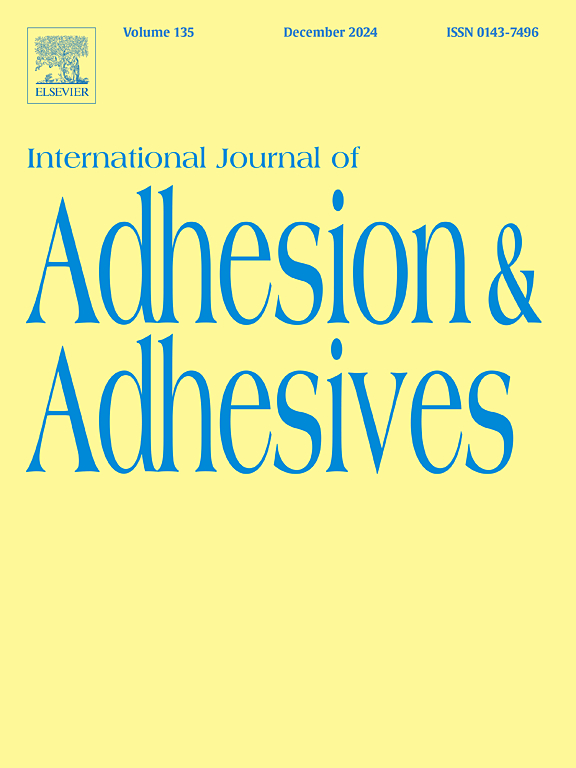Preparation of a multi-functional soy protein adhesive with toughness, mildew resistance and flame retardancy by constructing multi-bond cooperation
IF 3.5
3区 材料科学
Q2 ENGINEERING, CHEMICAL
International Journal of Adhesion and Adhesives
Pub Date : 2025-08-24
DOI:10.1016/j.ijadhadh.2025.104134
引用次数: 0
Abstract
Faced with petrochemical resource shortages, partially replacing aldehyde adhesives with bio-based soy protein adhesives is crucial, yet modified versions still suffer from high interfacial brittleness and inadequate anti-mildew/flame-retardant properties. This study constructed a soy protein adhesive composite system based on multiple bonding interactions, including covalent crosslinking, hydrogen bond, and ionic bond. The crosslinker triglyceride amine (TGA) crosslinked with soy protein to form a cross-linked structure; sodium alginate (SA) interacted with soy protein to form hydrogen bond; Mg2+ chelated with SA and soy protein to form ionic bond. Among them, covalent crosslinking served as the backbone structure, providing water resistance and strength for adhesive, while hydrogen and ionic bonds acted as sacrificial bonds, dissipating energy and improving the toughness of the adhesive. Compared to the SPI adhesive, the dry and wet shear strength of SPI/SA/Mg2+/TGA adhesive increased by 66.09 % and 199.07 % reaching 1.91 MPa and 0.96 MPa, respectively, and the tensile strain increased by 23.5 %–32.4 %; the moldy time improved from 2 d to more than 15 d; the limit oxygen index increased by 20.8 %–29.0 %. This modification strategy collectively enhancing bonding toughness, mildew resistance, and flame retardancy to advance industrial utilization of soy-based adhesives and sustainable development of artificial board binders.

通过构建多键配合制备具有韧性、抗霉性和阻燃性的多功能大豆蛋白胶粘剂
面对石油化工资源的短缺,用生物基大豆蛋白胶粘剂部分替代乙醛胶粘剂是至关重要的,但改性后的胶粘剂仍然存在界面脆性高、防霉阻燃性能不足的问题。本研究构建了一种基于共价交联、氢键、离子键等多键相互作用的大豆蛋白胶粘剂复合体系。交联剂甘油三酯胺(TGA)与大豆蛋白交联形成交联结构;海藻酸钠与大豆蛋白相互作用形成氢键;Mg2+与SA和大豆蛋白螯合形成离子键。其中,共价交联作为骨架结构,为胶粘剂提供抗水性和强度,氢键和离子键作为牺牲键,耗散能量,提高胶粘剂的韧性。与SPI胶粘剂相比,SPI/SA/Mg2+/TGA胶粘剂的干、湿抗剪强度分别提高了66.09%和199.07%,达到1.91 MPa和0.96 MPa,拉伸应变提高了23.5% ~ 32.4%;发霉时间由2 d提高到15 d以上;极限氧指数提高20.8% ~ 29.0%。这种改性策略共同提高了粘接韧性、抗霉性和阻燃性,促进了大豆基胶粘剂的工业利用和人造板粘合剂的可持续发展。
本文章由计算机程序翻译,如有差异,请以英文原文为准。
求助全文
约1分钟内获得全文
求助全文
来源期刊

International Journal of Adhesion and Adhesives
工程技术-材料科学:综合
CiteScore
6.90
自引率
8.80%
发文量
200
审稿时长
8.3 months
期刊介绍:
The International Journal of Adhesion and Adhesives draws together the many aspects of the science and technology of adhesive materials, from fundamental research and development work to industrial applications. Subject areas covered include: interfacial interactions, surface chemistry, methods of testing, accumulation of test data on physical and mechanical properties, environmental effects, new adhesive materials, sealants, design of bonded joints, and manufacturing technology.
 求助内容:
求助内容: 应助结果提醒方式:
应助结果提醒方式:


